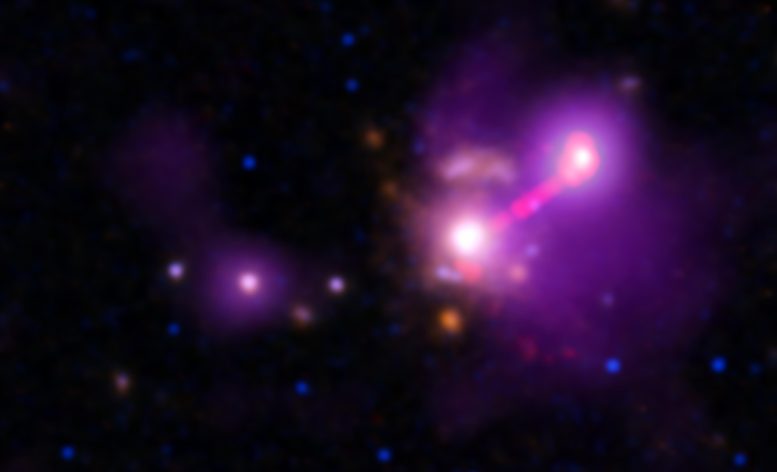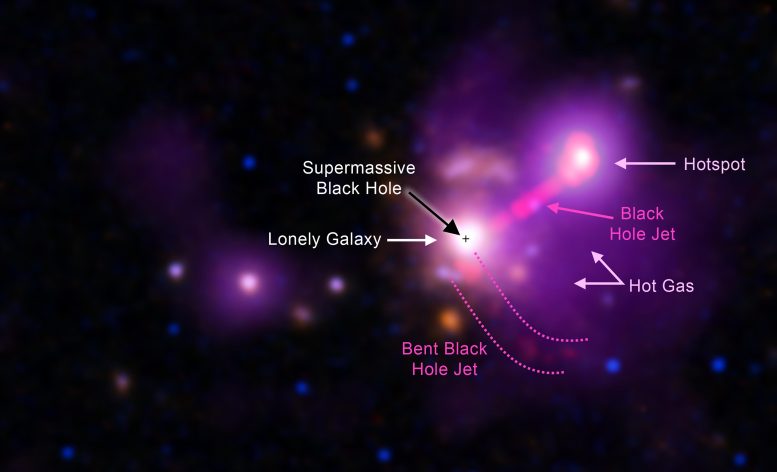
Astronomers have discovered an unusually lonely galaxy, 3C 297, using NASA’s Chandra X-ray Observatory and the International Gemini Observatory. Located 9.2 billion light-years from Earth, the galaxy appears to have assimilated its former companion galaxies, challenging current understanding of galaxy and galaxy cluster formation. Researchers suggest that 3C 297 could be a “fossil group,” the end stage of a galaxy merging with several others, making it the most distant fossil group discovered so far. Credit: X-ray: NASA/CXC/Univ. of Torino/V. Missaglia et al.; Optical: NASA/ESA/STScI & International Gemini Observatory/NOIRLab/NSF/AURA; Infrared: NASA/ESA/STScI; Radio: NRAO/AUI/NSF
The unexpectedly lonely galaxy 3C 297, discovered 9.2 billion light-years from Earth, has challenged existing theories on galaxy formation. Researchers suggest it may be the most distant “fossil group” ever discovered, where one galaxy has absorbed its former companions.
A distant — and lonely — galaxy appears to have pulled in and assimilated all of its former companion galaxies. This result made with NASA’s Chandra X-ray Observatory and the International Gemini Observatory may push the limits for how quickly astronomers expect galaxies to grow in the early universe.
The unexpectedly solo galaxy is located about 9.2 billion light-years from Earth and contains a quasar, a supermassive black hole pulling in gas at the center of the galaxy and driving powerful jets of matter seen in radio waves. The environment of this galaxy, known as 3C 297, appears to have the key features of a galaxy cluster, enormous structures that usually contain hundreds or even thousands of galaxies. Yet 3C 297 stands alone.
“It seems that we have a galaxy cluster that is missing almost all of its galaxies,” said Valentina Missaglia of the University of Torino in Italy, who led the study. “We expected to see at least a dozen galaxies about the size of the Milky Way, yet we see only one.”

The galaxy 3C297 has been discovered to be lonelier than expected, implying it has likely pulled in and absorbed its former companion galaxies. 3C297 contains a quasar, a supermassive black hole pulling in gas at the center of the galaxy and driving powerful jets of matter seen in radio waves. X-ray data from Chandra, radio data from the Karl G. Jansky Very Large Array and visible data from Gemini suggest that even though 3C297’s surroundings possess many features of a galaxy cluster, all but one galaxy remains. There is also visible light and infrared data from Hubble in this composite. Astronomers think this last large galaxy assimilated the others through its gravitational pull, and may push the limits for how quickly astronomers expect galaxies to grow in the early universe. Credit: X-ray: NASA/CXC/Univ. of Torino/V. Missaglia et al.; Optical: NASA/ESA/STScI & International Gemini Observatory/NOIRLab/NSF/AURA; Infrared: NASA/ESA/STScI; Radio: NRAO/AUI/NSF
Missaglia and her colleagues see two key traits of a galaxy cluster in the Chandra X-ray data. First, the X-ray data reveals the lone galaxy is surrounded by large quantities of gas with temperatures of tens of millions of degrees — something normally seen in galaxy clusters.
Second, the supermassive black hole’s jet has created an intense source of X-rays about 140,000 light-years away, implying that it has plowed into gas surrounding the galaxy. A third trait of galaxy clusters possessed by 3C 297, previously reported in Karl G. Jansky Very Large Array data, is that one of the radio jets is bent, showing that it has interacted with its surroundings.
Despite having these important features of a galaxy cluster, Missaglia’s team’s data from the Gemini Observatory in Hawaii revealed that none of the 19 galaxies that appear close to 3C 297 in a Gemini optical image, and that have accurate distance measurements, are actually at the same distance as the lonely galaxy.
“The question is, what happened to all of these galaxies?” said co-author Juan Madrid of the University of Texas, Rio Grande Valley. “We think the gravitational pull of the one large galaxy combined with interactions between the galaxies was too strong, and they merged with the large galaxy. For these galaxies apparently resistance was futile.”
The researchers think 3C 297 is no longer a galaxy cluster, but a “fossil group.” This is the end stage of a galaxy pulling in and merging with several other galaxies. While many other fossil groups have been detected before, this one is particularly distant, at 9.2 billion light-years away. (The previous record holders for fossil groups were at distances of 4.9 and 7.9 billion light-years.)
“It may be challenging to explain how the universe can create this system only 4.6 billion years after the big bang,” said co-author Mischa Schirmer of the Max Planck Institute for Astronomy. “This doesn’t break our ideas of cosmology, but it begins to push the limits on how quickly both galaxies and galaxy clusters must have formed.”
The authors cannot rule out the presence of dwarf galaxies around 3C 297, but their presence would still not explain the lack of larger galaxies like the Milky Way. Nearby examples are M87 in the Virgo Cluster, which has had large galactic companions for billions of years. However, 3C 297 will spend billions of years essentially alone.
For more on this discovery, see Astronomers Discover a Mysterious Lonely Galaxy.
The new study was published in the January 2023 issue of The Astrophysical Journal.
Reference: “Powerful Yet Lonely: Is 3C 297 a High-redshift Fossil Group?” by Valentina Missaglia, Juan P. Madrid, Mischa Schirmer, Francesco Massaro, Alberto Rodríguez-Ardila, Carlos J. Donzelli, Martell Valencia, Alessandro Paggi, Ralph P. Kraft Chiara Stuardi and Belinda J. Wilkes, 14 December 2022, The Astrophysical Journal.
DOI: 10.3847/1538-4365/ac9f3e
NASA’s Marshall Space Flight Center manages the Chandra program. The Smithsonian Astrophysical Observatory’s Chandra X-ray Center controls science operations from Cambridge, Massachusetts, and flight operations from Burlington, Massachusetts.









They didn’t form quickly. The BBT is just bonkers nonsense. We live in a stable state universe where the BBT is as likely to be true as Red Dwarf anecdotes like Future Echoes and Dwayne Dibley while the truth is black holes recycle everything all the time. Old galaxies are extinguished and new ones are formed. How much more money shall we waste chasing a dark matter dream?
World 🌏 Best news about NASA best regards united states 🇺🇸 of America
Hop
I’m always amazed how much smarter armchair scientists are than the scientists that spend a lot of time and money going to school to learn how to use the tools to gather data and do experiments to back up their hypotheses and theories. But those armchair scientists, man arm they good. All they have to do is read an article and by the end of it they know all the answers. We should all strive to be as good as armchair scientists.
The article states: Astronomers think this last large galaxy assimilated the others through its gravitational pull, and may push the limits for how quickly astronomers expect galaxies to grow in the early universe.
I guess the scientific basis for the theory that galaxies came into being by same evolutionary process remains on shaky ground. Therefore, it seems to me that the most up to date explanation for the origkn of galaxies remains: In the Beginning, God created …